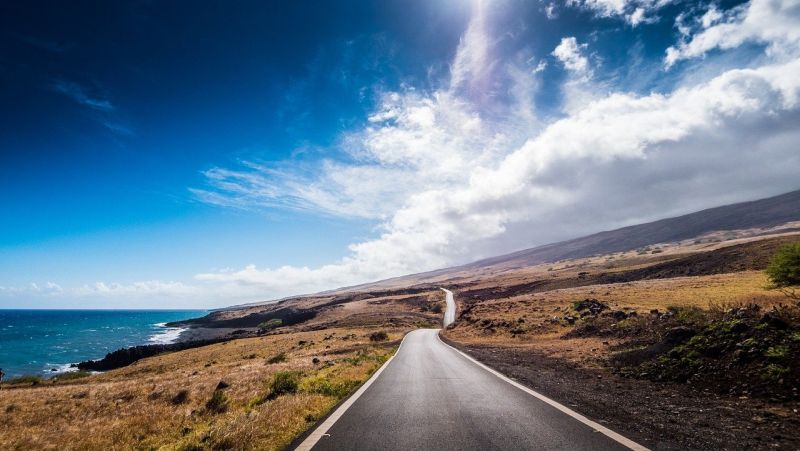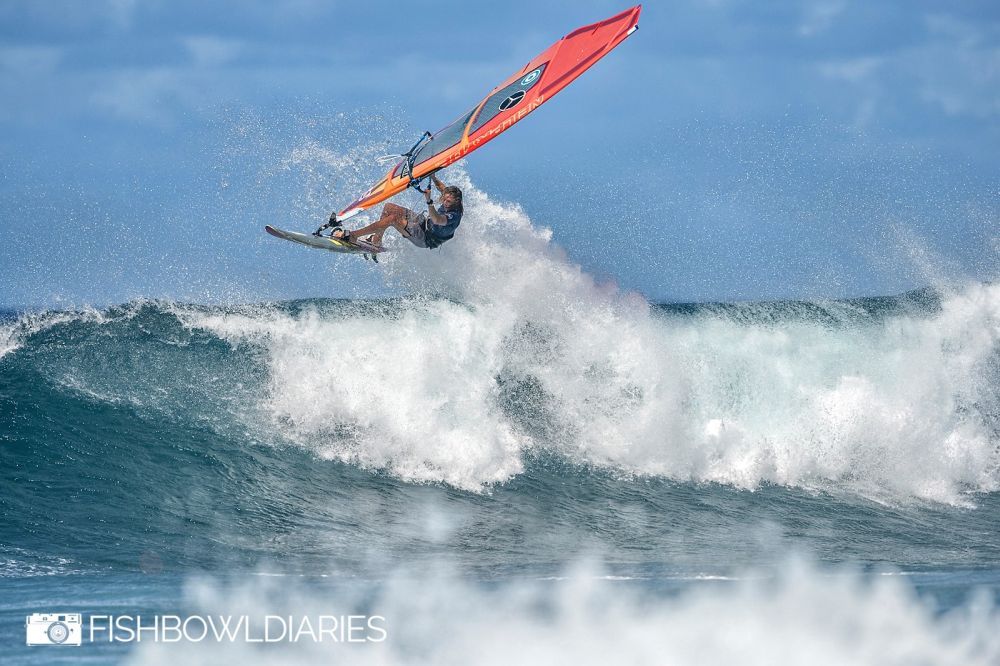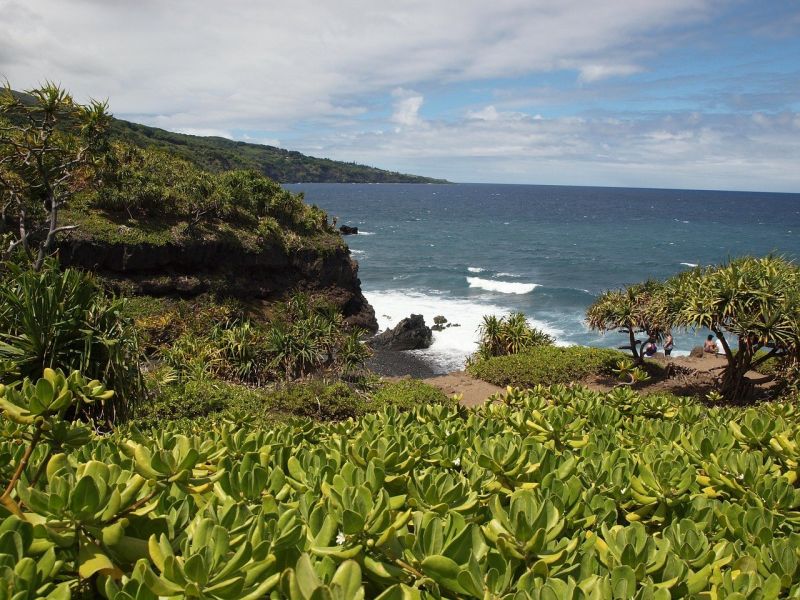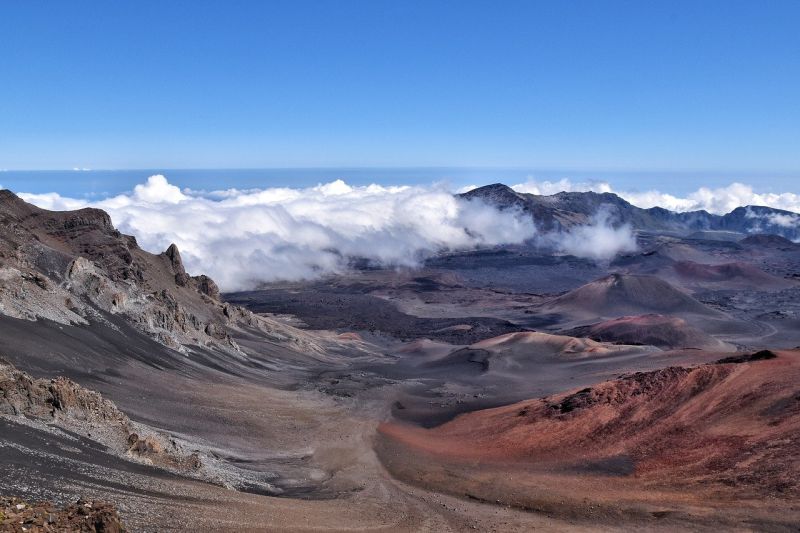The spots in Maui, Hawaii, are a dream for every windsurfing enthusiast. But are they such a forbidden dream? Let's hear what Daniele can tell us. He has been there twice, and he sent us this really detailed review.
Windsurfing, travels: Maui, Hawaii, United States of America. Impossible dream?
Listen to the poadcast, if you prefer (divided into two parts):
Hello everybody.
I will not dwell on the introduction, and I will not bore you by telling about my 2 holidays in Maui ('86 and '88). The purpose of this article is to ENCOURAGE YOU to evaluate a possible vacation in Maui (when moving will not involve too many problems related to the pandemic), and show you that - under the conditions specified below - it is an accessible trip for many wallets, now as then.
INGREDIENTS:
- 3 friends
- 2 months of vacation
- wild spirit (no luxury hotel or b&b, no dinners out)
- recommended period for windsurfers: autumn / winter
TOTAL COST PER HEAD:
about 3,600 Euros (about 4360 $) per person, including travel, board, car, petrol, accommodation and food
(breakfasts at the bar, and happy hours are not included in the calculation of the holiday cost).
Editor's note. The cost of the flight considers the departure from Italy. Probably, there are no significant differences starting from other European locations. In case of departure from other locations in the world, you must make the necessary price checks.
TO BRING WITH YOU:
- light clothing, some items for the rain, for excursions in the hinterland and on Haleakalā
- 3 sails, 2 masts, 1 boom, 1 extension
DOCUMENTS:
- passport
- ESTA authorization, to be able to stay on the island for 90 days without a visa (more information at the link: https://www.dhs.gov/visa-waiver-program-requirements)
HEALTH AND VACCINAL OBLIGATIONS:
- prior to the covid emergency, there were no vaccinal obligations
- now, it is necessary to be well informed, as the rules are constantly changing.
NOTE:
You can buy a "second hand" board (in reality, it will also be "eighth" hand, but there are some good ones, anyway), at a cost of about $ 400 (taking into account that you will resell it, if you do not destroy it).
Please note: you need to be at least 3 people, to reduce the costs of the car, apartment and petrol.
Please note: you must inquire in time, both for booking the apartment and the car.
RECENT INFORMATION:
This information was partly obtained thanks to a friend of mine, habitue to Maui (who is lucky enough to be hosted by his fraternal friends); others are derived from my experience, others recovered on the web.
DANGER NUMBER 1: going out at Ho'okipa, even in tempting conditions with small waves of 2 meters, if you are not skilled.
DANGER NUMBER 2: never coming back home.
Nowadays, it is economically demanding, if not impossible, to go to Maui with the family, to the various more or less luxury oceanfront resorts. BUT IT IS NOT, if you go "wild" (as I did). In this wild mode, the costs are affordable, especially if you have 2 friends, coming with you. So let's see in detail the costs to live two months in Maui, for windsurfing and hiking.


1. YOU NEED A RENTAL CAR
First of all, you need a car, because to reach the spots and places to visit you have to travel a few kilometers/miles, as we will see further.
I recommend renting a car at the Manaloha Rent a Car, run by the legendary Sergio Salaparuta. Sergio is a Roman guy, who moved to Maui more than 30 years ago; he will treat you well!
Do the negotiation ahead of time, by phone.
Expected cost (I stay high): $ 1,400 for two months.
2. THE COSTS FOR GASOLINE
Total cost: about 600 $ for two months, that is 7.000 Km/4350 miles of distance (staying low).
3. APARTMENT
Forget oceanfront apartments, as the prices are prohibitive, but there are beautiful accommodations inland, on the north coast. More precisely in the inland just above Paia, in the Makawao area and its surroundings; or further north of Paia, at Haiku. Below, I will show you the distances from the spots.
Total cost: $ 3,600 for two months.
4. THE COSTS FOR FOOD
Food costs more than in Italy, or other European countries, but with a total cost of $ 1,600 for two months, you'll have breakfast, lunch and dinner. Dinners out and various whims are excluded from the calculation.
5. AIR FLIGHT ROUND TRIP
Needless to say, it will be in economy, and there will be many stopovers, with different waiting times between one flight and the next one. Round-trip flights at the lowest prices are around 800 Euros (about 970 dollars), but you will have to spend a little more. Furthermore, the transport of the rig (whose weight should be about 17 kgs) must also be taken into account. Of course, the trip must be booked in time to lower costs.
Probable cost per person: $ 1,550$
COST SUMMARY
Before talking about the spots and places to visit, let's summarize the costs.
CAR RENTAL: $ 1,400
REFUELING EXPENSES: $ 600
ACCOMMODATION EXPENSES: $ 3,600
FOOD COSTS: $ 1,600
PARTIAL TOTAL: $ 7,200 or $ 2,400 each.
To the $ 2,400 each, we must add:
- THE COST OF THE BOARD: $ 400
- ROUND TRIP PLANE: $ 1,550
TOTAL COST: $ 4,350 or approximately € 3,600
(Insurance is not included in the calculation, which should be around $ 120 for two months)
CONSIDERATIONS ABOUT THE BOARD:
Some airlines manage to get advantageous prices for the transport of the rig and board, but be aware that, in Maui, if you organize in time, you can find used boards at $ 600 (which you will then resell at the same shop, most of the time, for 200 - 250 $, and therefore the cost you will pay will be about 350-400 $).
Try to bargain the board well before arriving in Maui, with a deposit directly via email; forget the websites.
The best known shops are:
- the renowned Second Hand (also reviewed here on Waterwind)
- The Maui Windsurf Company
- Hi Tech Surf Sports
Also at the spot beach, at Sprecks and Kanaha, you can find second-hand bargains (but I would leave this option only to those who do things at last).
In short, board, car, accommodation and flight require you to organize in time, and not to do things at the last moment.

THE MAIN SPOTS AND RELATIVE DISTANCES FROM THE ACCOMMODATION
As mentioned, accommodation is to be found in the Makawao and Haiku area.
The distance between these two places and Paia are 5.5 miles and 7 miles respectively.
The distances from the main spots are:
Makawao → Sprecks: 8 miles
Haiku → Sprecks: 8 miles
Makawao → Kanaha: 12 miles
Haiku → Kanaha: 12 miles
Makawao → Ho'okipa: 9 miles
Haiku → Ho'okipa: 4 miles
Makawao → Lanes: 9 miles
Haiku → Lanes: 4 miles
Makawao → Peʻahi (Jaws): 8 miles (but you will come to a viewpoint)
Haiku → Peʻahi (Jaws): 4.5 miles (but you will come to a viewpoint)
Before going into the explanations of the spots, here is a quick overview to start orienting yourself where to ride, based on your skills.
SPOTS OVERVIEW
The spots for medium / good windsurfers are Kuau Bay, Sprecks, Camp One, Kanaha (Upper Kanaha also for beginners); while the best can opt for Lanes (wind conditions permitting); the more experienced and pros can opt for Ho'okipa, instead the pros and the crazy ones for Jaws.
In all these spots, you usually go out on starboard tack. On rare occasions, when the Kona blows, you exit to port tack. With Kona wind, the ideal spot is Lanes.
MAIN WINDS
Maui's winds are a lot, and vary from district to district, but the main one, which you will enjoy most of the time - and will allow you to jump on starboard tack and ride port tack - is generally called Makani. So it is the wind that will guarantee excellent side shore conditions. Sometimes, side onshore conditions occur, with exit always on the starboard tack; in this case the wind is called Moa'e. Instead, the Kona, as already mentioned, is a wind from side shore conditions, but with exit on port tack. So, you jump on port tack, and surf on starboard tack.
I would forget the wind and the Kihei spot (being a windswept spot mainly in the summer season), most of the time not interesting in the winter season, unless you are a beginner.
RULES TO COMPLY
Most of the beaches are regulated by local laws. For example, there are areas where you cannot ride before 11 am; there are other areas, such as Ho'okipa, where the 10 surfers rule applies, that is, if there are 10 surfers in the water, you can not go out with your windsurf.
Another noteworthy rule is that you cannot park where you like; do not dare to park in front of driveways, because the locals do not forgive you (it happened in the past, and they told me it still happens today).
HO’OKIPA
Ho'okipa is to be feared even when there are inviting conditions (I have a scar as a reminder of a wipe out at the first ride, the wave was mast high, I was... an idiot) with waves of two meters. The reason is obvious: the two-meter waves in that spot are bad, and if you do a wipe out, most likely, you will end up on the rocks. In that case, there will be problems, not only for the equipment but also for yourself. Furthermore, getting out and back, at Ho'okipa, is not that simple. Furthermore, getting out and back, at Ho'okipa, is not that simple. You have to cross a narrow passage, where you have the only point where the seabed is free of rocks. And you need to know how to manage well rights of way, because, at Ho'okipa, the utmost respect applies.
LANES
Lanes is about 500 meters downwind of Ho'okipa. The waves are challenging, but never like those of Ho'okipa. A good windsurfer will have fun on these waves, but will have to consider that the exit and return to the beach are not easy, because the sand has given way to the rocks. Remember that Lanes is great with the Kona, as you can see in this video: https://www.continentseven.com/video-kona-winds-at-lanes-maui/
KUAU BAY
Kuau Bay is near Paia, and is located between Paia and Lanes. Sometimes it gives some spectacular conditions for the average / good windsurfer with those beautiful waves that are easy and very long to surf. You can get an idea by watching this video at the minute 01:40: (Video Kuau Bay)
SPRECKS
Sprecks is a spot, crowded with Germans and Europeans. You have to arrive early in the morning to find parking. Be careful not to get bogged down in the sand. Access to water is usually easy, but sometimes (when at Ho'okipa there are 2 mast high waves), at Sprecks the shorebreak can be as high as 1,5 meters. To reach the Sprecks waves zone, you have to ride a bit upwind. If, on the other hand, you go out riding abeam, you will find yourself in a situation where - at a distance of 150 meters from the shore, but not always - a small, fast frontal wave of just one meter rises. It's funny for: jumping and practicing with the forward loop; also nice, to do half a 360 downwind, and ride backwind, pushed by the wave. Sprecks waves are usually just over 2 meters, but sometimes even 3,5 meters. Of course they can be surfed front-side, but they are not long waves, so you can do just 2 bottom turns and 1 cut-back. If, on the other hand, you go out slightly sailing to reach, you will end up in an area where the waves are almost oriented in the direction of the wind, and can be surfed for a short time in the backside, but they are good for learning to do the back loop, without being slammed into the space.... In this area, the various airplanes landing and taking off to / from Kahului airport will pass over your head.
You jump on starboard tack, here. Sprecks is a spot where the wind is constant, there are few lulls. Usually in the autumn / winter period you go out with sails of 4.2/4.5 mq (rider of 70-80 kgs). It is a guarantee, regarding the wind. An idea of the conditions that you will often find here is shown in this video (Video Sprecks)
ATTENTION: offshore, at Sprecks, you can come across very high walls of water.


CAMP ONE
Camp One is located between Sprecks and Upper Kanaha. You can get there (I believe even today) only by sea, through a close-hauled, not difficult, ride, if you start from Upper Kanaha; or with a short reach, if you start from Sprecks. The conditions are very interesting, so that you will find pros who train in the water, when Ho’okipa is very gusty, or when the conditions are too bad to try and improve moves and tricks.
Watching videos (Video Camp One 1) (Video Camp One 2), you realize that the conditions are not prohibitive for the good windsurfer. You don't need to be an expert to go out in this spot. Under certain conditions, even an average / good windsurfer can have fun.
KANAHA
Kanaha is a spot suitable for everyone, from beginners to experts, since there are areas where there is flat water, in other 2-meter waves that do not break (sleepy waves), and can be surfed for a long time, then bad waves of 2-3 meters. Furthermore, there are very challenging and dangerous waves, not only for the heights, but also for the currents. These waves (not comparable, however, to Ho’okipa ones) can be found in the area called "The Weird Wave", that is, halfway between Upper Kanaha and Lower Kanaha. Non-experts would have better avoid this point as, in the case of a wipe out, rip curls lead offshore. Offshore you can find very challenging waves.
As you may have guessed, Kanaha is a very large beach and allows windsurfers to find their own comfort zone.
In various areas of Kanaha, significant shorebreak situations are very rare, so that the exit in the water is easy, even for those who are beginners with the beach start.
There are no congested parking problems like in previous spots. Unlike Sprecks, the wind blows with less intensity, and during the waveriding sessions it often happens that you surf with the sail without lift.
Lower Kanaha is also the show here: (Video Kanaha)

IN A FEW WORDS, YOU CAN SUMMARIZE EVERYTHING THIS WAY:
Jaws only for the pros or the crazy ones. Ideal for waveriding big waves.
Ho'okipa for experts and pros. Ideal for waveriding and jumping.
Lanes for good, experienced and proS. Ideal for waveriding.
Kuau bay for medium/good. Ideal for light waveriding.
Sprecks for good and medium / good. Ideal for jumps. The waverides are short.
Camp One for good and medium / good. It is better than Sprecks, when it comes to jumping and surfing, and it is less crowded in the water.
Kanaha for beginners, advanced, medium / good, good and experienced. Ideal for light waveriding, and in certain conditions also for jumps and waveriding for good and experienced windsurfers.
It must be said that the heights and the difficulty of the waves, even in places for non-experts, can vary according to the so-called north swell.
VERY IMPORTANT RECOMMENDATION
Avoid wandering around the island in search of the fantastic and secret windsurfing spot, which may seem suitable for your level. The problem is the currents and the seabed that would put even the pros in difficulty. As an example, here is a fantastic spot only for pros, even when conditions are less challenging than these: (Video La Perouse Bay)
In the next post, I will tell you about the locations that you must visit and other curiosities.
Hang Loose!
Daniele
Without your Support, Waterwind wouldn't exist. Become our supporter!
If you want to advertise with us, read here, or contact us.
Collaborate with us. Read here!
Buy our Gadgets! Visit our YouTube channel!




